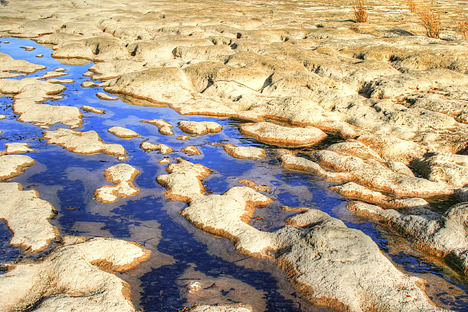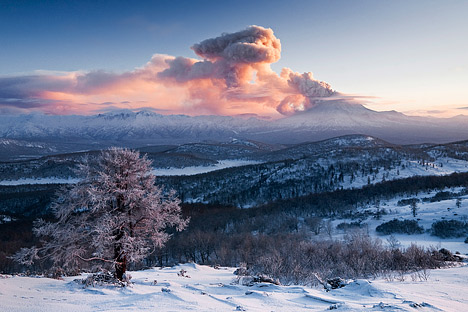How The Calcium In An Animal Bones Might Be Cycled Back Into The Environment
The Deadening Carbon Wheel
Through a series of chemic reactions and tectonic activity, carbon takes between 100-200 million years to move between rocks, soil, ocean, and atmosphere in the slow carbon wheel. On average, 10xiii to tenfourteen grams (10–100 million metric tons) of carbon movement through the ho-hum carbon bike every year. In comparison, homo emissions of carbon to the temper are on the guild of 1015 grams, whereas the fast carbon bicycle moves 1016 to ten17 grams of carbon per year.
The movement of carbon from the atmosphere to the lithosphere (rocks) begins with rain. Atmospheric carbon combines with h2o to form a weak acid—carbonic acid—that falls to the surface in rain. The acid dissolves rocks—a procedure called chemic weathering—and releases calcium, magnesium, potassium, or sodium ions. Rivers carry the ions to the ocean.

Rivers carry calcium ions—the result of chemical weathering of rocks—into the ocean, where they react with carbonate dissolved in the water. The production of that reaction, calcium carbonate, is then deposited onto the ocean floor, where it becomes limestone. (Photograph ©2009 Greg Carley.)
In the ocean, the calcium ions combine with bicarbonate ions to form calcium carbonate, the active ingredient in antacids and the chalky white substance that dries on your faucet if you live in an area with difficult water. In the modern ocean, most of the calcium carbonate is made by trounce-edifice (calcifying) organisms (such every bit corals) and plankton (similar coccolithophores and foraminifera). Afterwards the organisms die, they sink to the seafloor. Over fourth dimension, layers of shells and sediment are cemented together and turn to rock, storing the carbon in stone—limestone and its derivatives.

Limestone, or its metamorphic cousin, marble, is stone made primarily of calcium carbonate. These rock types are often formed from the bodies of marine plants and animals, and their shells and skeletons tin can be preserved as fossils. Carbon locked up in limestone can be stored for millions—or even hundreds of millions—of years. (Photograph ©2008 Rookuzz (Hmm).)
Merely 80 per centum of carbon-containing rock is currently fabricated this fashion. The remaining 20 percent contain carbon from living things (organic carbon) that have been embedded in layers of mud. Heat and pressure compress the mud and carbon over millions of years, forming sedimentary rock such equally shale. In special cases, when dead plant matter builds up faster than information technology tin can decay, layers of organic carbon become oil, coal, or natural gas instead of sedimentary rock like shale.

This coal seam in Scotland was originally a layer of sediment, rich in organic carbon. The sedimentary layer was eventually buried deep underground, and the heat and pressure transformed it into coal. Coal and other fossil fuels are a user-friendly source of free energy, simply when they are burned, the stored carbon is released into the atmosphere. This alters the remainder of the carbon cycle, and is irresolute Earth'due south climate. (Photograph ©2010 Sandchem.)
The dull cycle returns carbon to the temper through volcanoes. Earth's country and ocean surfaces sit on several moving crustal plates. When the plates collide, i sinks beneath the other, and the rock it carries melts under the farthermost rut and pressure. The heated stone recombines into silicate minerals, releasing carbon dioxide.
When volcanoes erupt, they vent the gas to the atmosphere and cover the land with fresh silicate rock to begin the cycle again. At present, volcanoes emit betwixt 130 and 380 million metric tons of carbon dioxide per year. For comparison, humans emit about 30 billion tons of carbon dioxide per year—100–300 times more than volcanoes—by burning fossil fuels.
Chemistry regulates this dance between ocean, state, and atmosphere. If carbon dioxide rises in the atmosphere because of an increase in volcanic activity, for case, temperatures ascension, leading to more than rain, which dissolves more than rock, creating more than ions that volition somewhen deposit more carbon on the bounding main flooring. Information technology takes a few hundred thousand years to rebalance the boring carbon cycle through chemic weathering.

Carbon stored in rocks is naturally returned to the atmosphere by volcanoes. In this photo, Russian federation's Kizimen Volcano vents ash and volcanic gases in January 2011. Kizimen is located on the Kamchatka Peninsula, where the Pacific Plate is subducting beneath Asia. (Photograph ©2011 Artyom Bezotechestvo/Photo Kamchatka.)
However, the irksome carbon wheel also contains a slightly faster component: the ocean. At the surface, where air meets water, carbon dioxide gas dissolves in and ventilates out of the ocean in a steady exchange with the atmosphere. Once in the ocean, carbon dioxide gas reacts with h2o molecules to release hydrogen, making the body of water more than acidic. The hydrogen reacts with carbonate from rock weathering to produce bicarbonate ions.
Before the industrial historic period, the bounding main vented carbon dioxide to the atmosphere in balance with the carbon the ocean received during stone weathering. Notwithstanding, since carbon concentrations in the atmosphere have increased, the body of water now takes more carbon from the atmosphere than information technology releases. Over millennia, the ocean will absorb up to 85 per centum of the extra carbon people have put into the temper by burning fossil fuels, but the process is slow because it is tied to the motion of water from the ocean's surface to its depths.
In the concurrently, winds, currents, and temperature control the rate at which the body of water takes carbon dioxide from the atmosphere. (See The Ocean's Carbon Balance on the World Observatory.) It is probable that changes in ocean temperatures and currents helped remove carbon from and and so restore carbon to the temper over the few thousand years in which the ice ages began and ended.
Source: https://earthobservatory.nasa.gov/features/CarbonCycle/page2.php
Posted by: austinuntoonesch.blogspot.com

0 Response to "How The Calcium In An Animal Bones Might Be Cycled Back Into The Environment"
Post a Comment